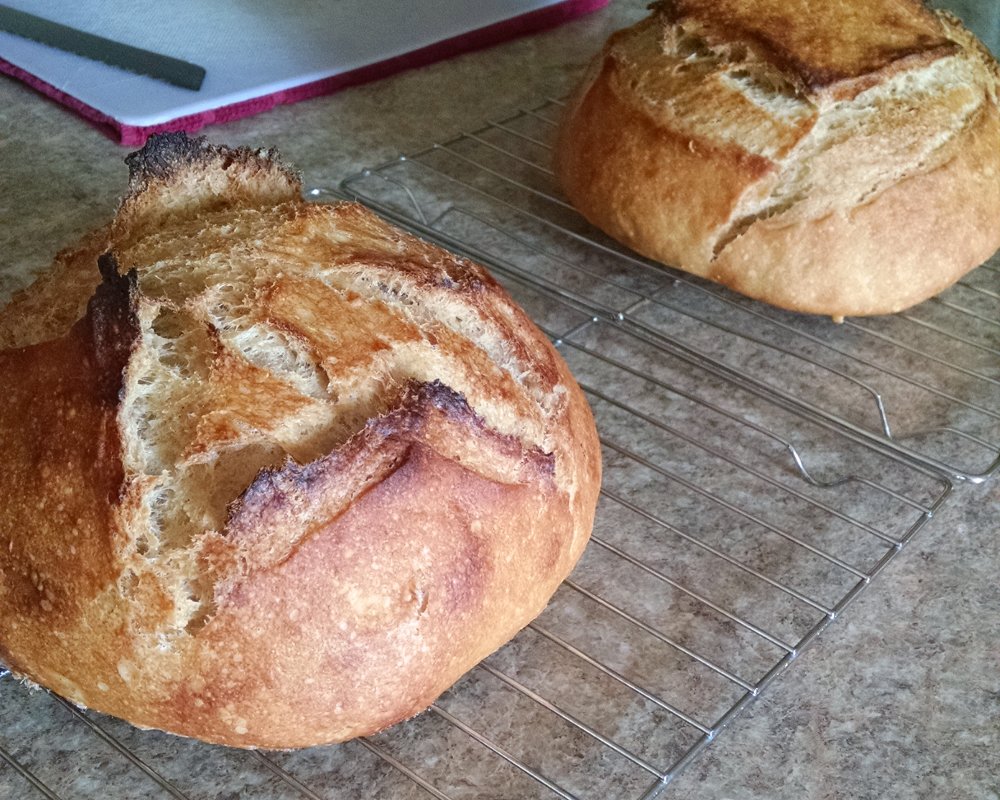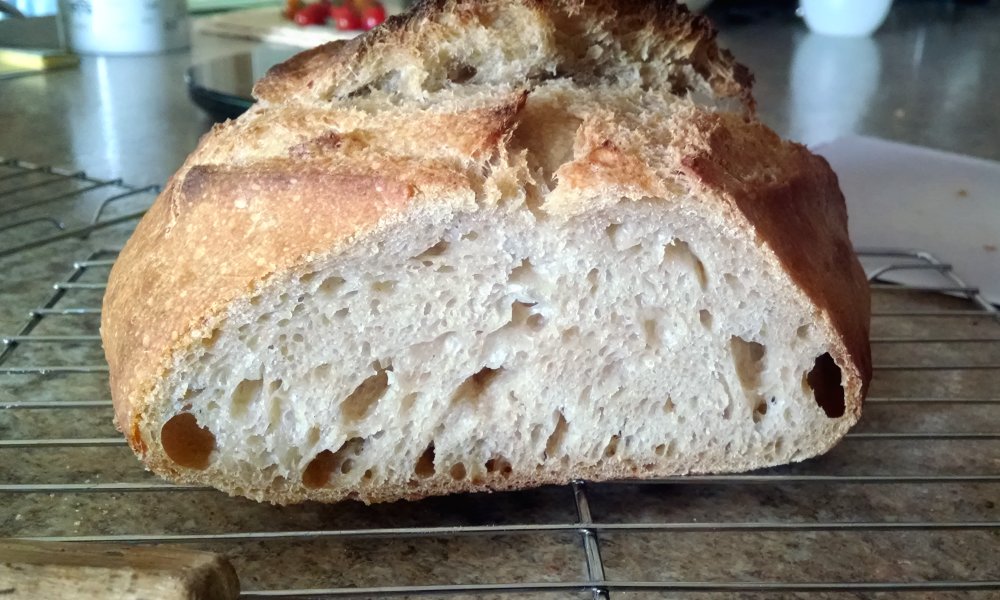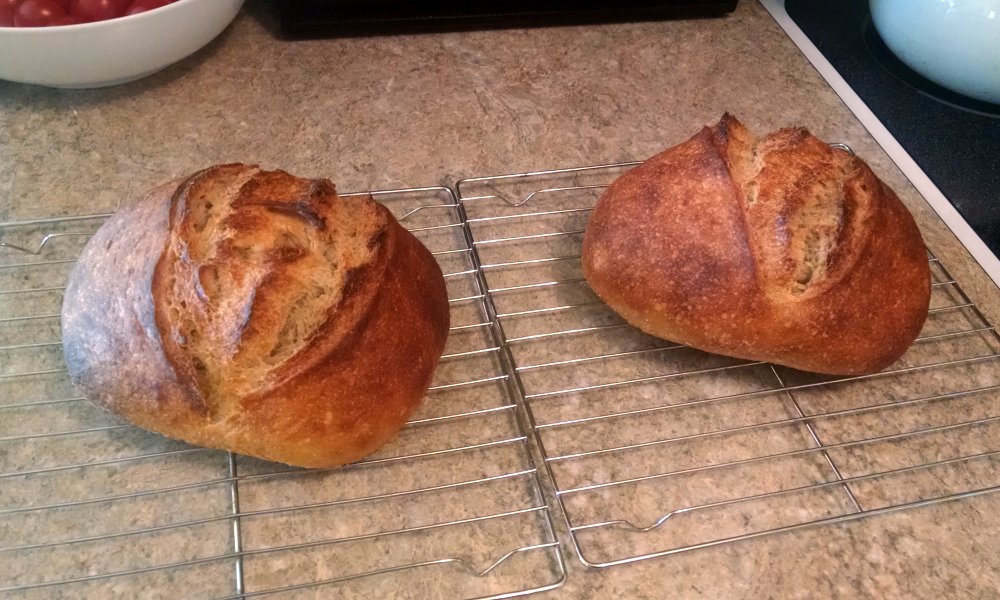
Summer has been interesting, bread-baking-wise. I went for a largely disastrous stretch trying to make higher-hydration, relatively slack doughs into bread because moisture seemed to be the key to wonderful artisan loaves. (You will note that none of those have been posted, and for good reason!) And the heat and humidity necessitated several changes to the way I feed and process my doughs, because we only use the air-conditioner as a last resort. It'll be nice when autumn really takes hold!
All that experimentation started with David Snyder's San Joaquin sourdough (SJSD to many of us), and went a lot of wild places in the middle that didn't work so well, but I came out of it with another recipe that works for me—and a lot better at bread than I was beforehand!
What I have now is about 70.5% hydration, 17.5% white whole wheat (I got up to 20% in experimentation and my wife called "too much," so I backed off to here), and builds from a tiny amount of refrigerated starter with no excess, baking on the third day. I find it wonderfully sour, though that's not everyone's thing, and this is the first bread I've made that comes near my wife's wistful recollections of San Francisco.

It makes really nice boules, though I'm learning a finer balance between shaping and proofing to keep them from tearing open quite so hard. I've had several batard bakes before this split open in ways the slashes could barely control! Below are the good examples.



I've started to do the single slash down the middle because it gives us a loaf of reasonably uniform slice size, oblong without having to try to make an oblong loaf (which I definitely haven't mastered yet!). But so far, the angled slash that's supposed to give me nice grigne (post top) is providing half grigne, half blowout; the deep vertical slash (last, above) seems to control expansion better. These boules seem to turn out a bit denser in the middle than at the edges, so I've still got some fiddling to do with my handling and proofing, but it's getting better.
- eleutheros's Blog
- Log in or register to post comments
I think 30 - 40% whole sprouted multi grain at 75-77% hydration is my personal, favorite tasting version of Davids SJSD methods. its getting pretty far away from his flours used but it was the method that counts,
All of your versions look great - both inside and out ! Well done and
Happy baking
...as you are when it comes to what goes in my breads. Not least because my wife and I tend to prefer to have things on our daily bread rather than in it, in terms of texture, so it's all a question of flours. And I'm just barely dipping my toes in the water when it comes to other grains than wheat.
Do you find that flour from sprouted grains in general speeds up fermentation? I've been experimenting with malted barley, which definitely makes my culture run through a given mass of flour faster; it's been a matter of figuring out when I want that boost.
These look like very appetising loaves and some nice photographs. High dough expansion while baking doesn't sound too bad and the results you have posted look great. Happy baking! Colin.
Yeah, I'm actually pretty pleased with the level of dough expansion/oven spring. I just wish I had a better way to keep a nice crust around it, expanding with it. I may have to try rigging up some sort of cloche so the crust doesn't set up so fast; I haven't yet gone in for the dutch oven, much as I love cast iron. My oven holds a fair amount of steam, but not enough for that kind of delayed set!
Those look great!
And I really enjoyed your post. Your sashay in to high hydration seems like it could be mine. I am still finding bits of flung dough in my kitchen. I've come to grips with my lack of expertise and, like you, I have decided to move on for the time being. I just can't get the high hydration to be something I feel really good about. I'm now using the "Chorkish" method. little bit od Forkish and a little bit of Chad. And a whole lot of whatever works that day.
I have seen a very clever improvised cloche made from a large inverted terracotta flowerpot. It had a nice big metal hook and washers from a hardware store used to make a handle and close the drainage hole in bottom of the pot. The whole thing is heated-up in the oven, with a baking stone used for the base. A neat idea.
Here's a link to the thread, which includes a photo: http://www.thefreshloaf.com/node/10477/homemade-cloche
I have a La Cloche, but for my last few bakes have steamed the oven with a cast iron pan on the base of the oven and, to be honest, I think I have had slightly better results.
... works great for me. I have a 12" Lodge pan that I leave on the lower rack, as both steam source and heat capacitor. My loaves go on sheet pans with parchment on the upper rack, and about a cup of hot water magically disappears into steam off the hot cast iron as I shut the door. I may simply see what more steam will do, but that improvised terra cotta rig gives me ideas. Thanks!
Enjoyed your photos, I thought that I was probably the last neanderthal to write out the formula on a yellow legal pad. Nice bread!
I'm a doctoral student in theology and ethics, and I live and die by legal pads! Hardly an efficient way of doing things, but something about it beats side-flip notebooks for a lot of general work. I have piles of them ... if only I had someone to transcribe them all! Now that would make me a Neanderthal: a theology professor with a secretary who handles typing up all the handwritten notes. Ancient.